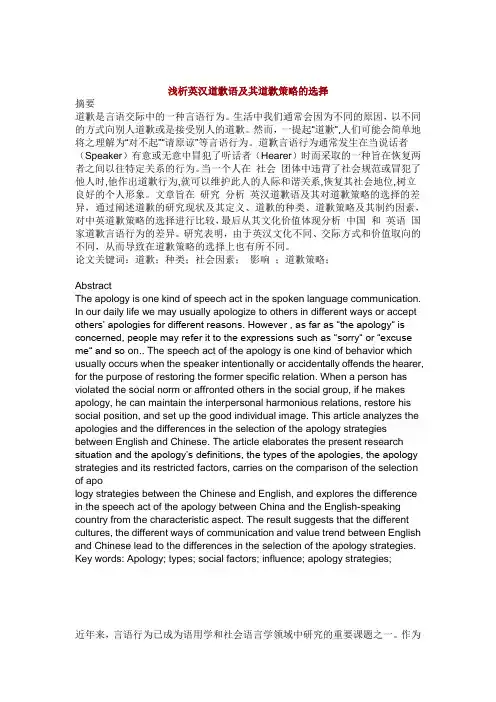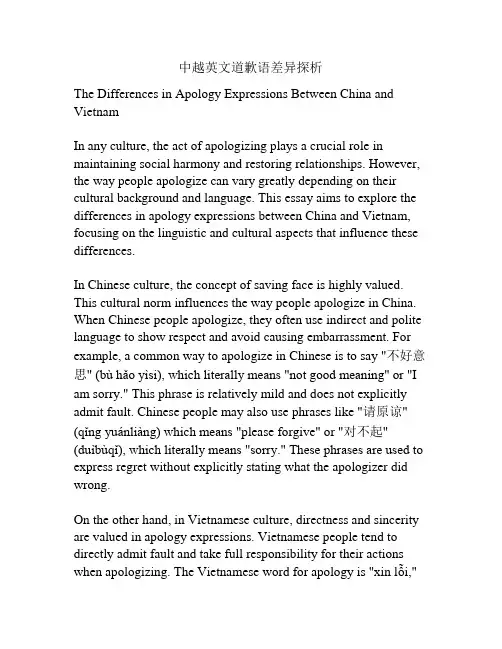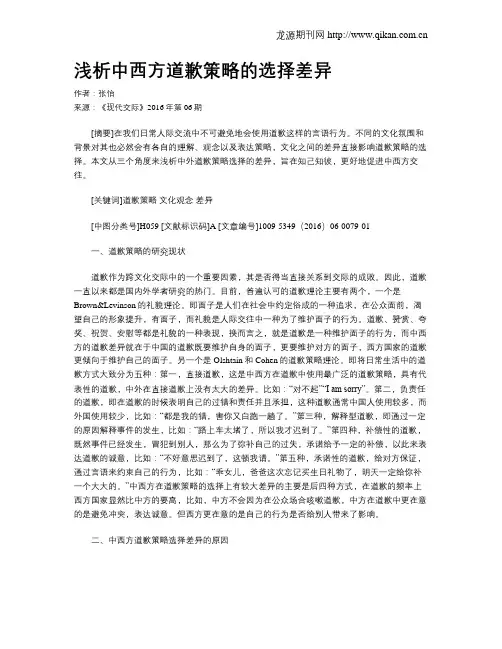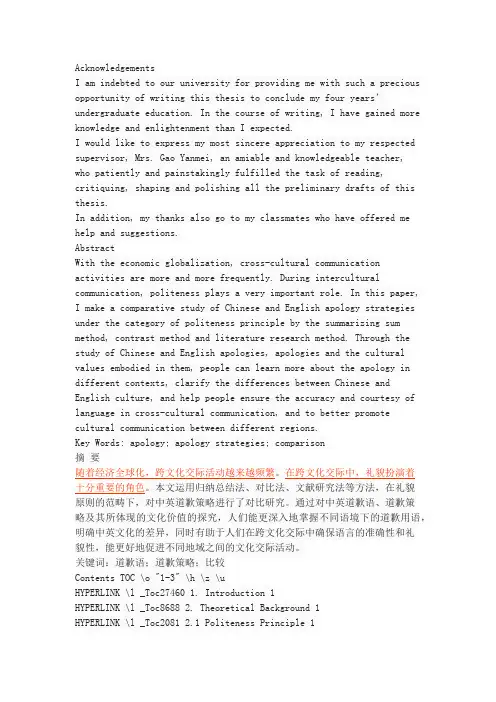中澳大学生英语道歉策略的对比研究
浅析英汉道歉语及其道歉策略的选择

浅析英汉道歉语及其道歉策略的选择摘要道歉是言语交际中的一种言语行为。
生活中我们通常会因为不同的原因,以不同的方式向别人道歉或是接受别人的道歉。
然而,一提起“道歉”,人们可能会简单地将之理解为“对不起”“请原谅”等言语行为。
道歉言语行为通常发生在当说话者(Speaker)有意或无意中冒犯了听话者(Hearer)时而采取的一种旨在恢复两者之间以往特定关系的行为。
当一个人在社会团体中违背了社会规范或冒犯了他人时,他作出道歉行为,就可以维护此人的人际和谐关系,恢复其社会地位,树立良好的个人形象。
文章旨在研究分析英汉道歉语及其对道歉策略的选择的差异,通过阐述道歉的研究现状及其定义、道歉的种类、道歉策略及其制约因素,对中英道歉策略的选择进行比较,最后从其文化价值体现分析中国和英语国家道歉言语行为的差异。
研究表明,由于英汉文化不同、交际方式和价值取向的不同,从而导致在道歉策略的选择上也有所不同。
论文关键词:道歉;种类;社会因素;影响;道歉策略;AbstractThe apology is one kind of speech act in the spoken language communication. In our daily life we may usually apologize to others in different ways or accept others’ apologies for different reasons. However , as far as “the apology“ is concerned, people may refer it to the expressions such as “sorry“ or “excuse me“ and so on.. The speech act of the apology is one kind of behavior which usually occurs when the speaker intentionally or accidentally offends the hearer, for the purpose of restoring the former specific relation. When a person has violated the social norm or affronted others in the social group, if he makes apology, he can maintain the interpersonal harmonious relations, restore his social position, and set up the good individual image. This article analyzes the apologies and the differences in the selection of the apology strategies between English and Chinese. The article elaborates the present research situation and the apology’s definitions, the types of the apologies, the apology strategies and its restricted factors, carries on the comparison of the selection of apology strategies between the Chinese and English, and explores the difference in the speech act of the apology between China and the English-speaking country from the characteristic aspect. The result suggests that the different cultures, the different ways of communication and value trend between English and Chinese lead to the differences in the selection of the apology strategies. Key words: Apology; types; social factors; influence; apology strategies;近年来,言语行为已成为语用学和社会语言学领域中研究的重要课题之一。
中越英文道歉语差异探析

中越英文道歉语差异探析The Differences in Apology Expressions Between China and VietnamIn any culture, the act of apologizing plays a crucial role in maintaining social harmony and restoring relationships. However, the way people apologize can vary greatly depending on their cultural background and language. This essay aims to explore the differences in apology expressions between China and Vietnam, focusing on the linguistic and cultural aspects that influence these differences.In Chinese culture, the concept of saving face is highly valued. This cultural norm influences the way people apologize in China. When Chinese people apologize, they often use indirect and polite language to show respect and avoid causing embarrassment. For example, a common way to apologize in Chinese is to say "不好意思" (bù hǎo yìsi), which literally means "not good meaning" or "I am sorry." This phrase is relatively mild and does not explicitly admit fault. Chinese people may also use phrases like "请原谅" (qǐng yuánliàng) which means "please forgive" or "对不起"(duìbùqǐ), which literally means "sorry." These phrases are used to express regret without explicitly stating what the apologizer did wrong.On the other hand, in Vietnamese culture, directness and sincerity are valued in apology expressions. Vietnamese people tend to directly admit fault and take full responsibility for their actions when apologizing. The Vietnamese word for apology is "xin lỗi,"which is used in various contexts and situations. This phrase is straightforward and translates directly to "I am sorry." Vietnamese people believe in the importance of sincerity and taking ownership of one's mistakes when apologizing.The linguistic differences between Chinese and Vietnamese also influence the way people apologize in these two cultures. Chinese is a tonal language with many homophones, which allows for various interpretations and layers of meaning in apology expressions. This linguistic feature is reflected in the indirect and ambiguous way Chinese people apologize. Vietnamese, on the other hand, is a tonal language with fewer homophones, which leads to a more direct and explicit way of apologizing.Additionally, the cultural values and historical background of China and Vietnam contribute to the differences in apology expressions. Chinese culture places a strong emphasis on hierarchy and respecting authority. This cultural aspect influences the way people apologize, as they may use more polite and deferential language when apologizing to someone higher in the social hierarchy. Vietnamese culture, on the other hand, tends to be more egalitarian, emphasizing egalitarianism and equality. Vietnamese people may use language that is direct and equal when apologizing to others, regardless of their social status or position.Furthermore, historical conflicts and interactions between China and Vietnam have shaped their cultural norms and attitudes towards apology. China and Vietnam have had a complex relationship marked by both cooperation and conflict throughout history. This historical context is reflected in their apologyexpressions. Chinese people may feel hesitant to admit fault fully due to historical sensitivities and concerns about saving face. On the other hand, Vietnamese people may adopt a more direct and straightforward approach to apology influenced by historical experiences of colonization and the struggle for independence.In conclusion, while the act of apologizing is universal, the way people apologize in different cultures can vary significantly. In China, the concept of saving face and indirectness often influences how people apologize, using polite language that avoids explicit admission of fault. Vietnamese culture, on the other hand, values directness and sincerity, leading to more straightforward apologies that openly admit fault and take responsibility. Linguistic features and cultural values, as well as historical background, all contribute to these differences in apology expressions between China and Vietnam. Understanding and respecting these cultural differences can help promote effective communication and establish better understanding between people of different cultural backgrounds.。
浅析中西方道歉策略的选择差异

浅析中西方道歉策略的选择差异作者:张怡来源:《现代交际》2016年第06期[摘要]在我们日常人际交流中不可避免地会使用道歉这样的言语行为。
不同的文化氛围和背景对其也必然会有各自的理解、观念以及表达策略,文化之间的差异直接影响道歉策略的选择。
本文从三个角度来浅析中外道歉策略选择的差异,旨在知己知彼,更好地促进中西方交往。
[关键词]道歉策略文化观念差异[中图分类号]H059 [文献标识码]A [文章编号]1009-5349(2016)06-0079-01一、道歉策略的研究现状道歉作为跨文化交际中的一个重要因素,其是否得当直接关系到交际的成败。
因此,道歉一直以来都是国内外学者研究的热门。
目前,普遍认可的道歉理论主要有两个,一个是Brown&Levinson的礼貌理论。
即面子是人们在社会中约定俗成的一种追求,在公众面前,渴望自己的形象提升,有面子,而礼貌是人际交往中一种为了维护面子的行为。
道歉、赞赏、夸奖、祝贺、安慰等都是礼貌的一种表现,换而言之,就是道歉是一种维护面子的行为,而中西方的道歉差异就在于中国的道歉既要维护自身的面子,更要维护对方的面子,西方国家的道歉更倾向于维护自己的面子。
另一个是Olshtain和Cohen的道歉策略理论。
即将日常生活中的道歉方式大致分为五种:第一,直接道歉,这是中西方在道歉中使用最广泛的道歉策略,具有代表性的道歉,中外在直接道歉上没有太大的差异。
比如:“对不起”“I am sorry”。
第二,负责任的道歉,即在道歉的时候表明自己的过错和责任并且承担,这种道歉通常中国人使用较多,而外国使用较少,比如:“都是我的错,害你又白跑一趟了。
”第三种,解释型道歉,即通过一定的原因解释事件的发生,比如:“路上车太堵了,所以我才迟到了。
”第四种,补偿性的道歉,既然事件已经发生,冒犯到别人,那么为了弥补自己的过失,承诺给予一定的补偿,以此来表达道歉的诚意,比如:“不好意思迟到了,这顿我请。
道歉信的中英对照范例和对比分析

道歉信的中英对照范例和对比分析道歉信是一种表达歉意和道歉的正式信函,常用于商务和个人场合。
在国际交流中,中英文化差异导致了道歉信的写作方式和表达方式上的差异。
本文将以中英对照的方式,分析道歉信的范例,并对比两种文化中的差异。
范例一:亲爱的李先生,非常抱歉给您带来了不便。
我写此信是为了向您表达我对上次会议迟到的歉意。
事实上,我原本计划提前出发,但因为交通拥堵,我遇到了无法预料的延误。
我深知这对您和其他与会人员造成了困扰,对此我深感抱歉。
我对我的疏忽感到非常愧疚,我将确保以后不再发生类似的情况。
我会更加注意时间管理,并提前规划行程,以确保准时到达。
再次对给您带来的不便表示道歉,希望您能理解我的困境。
如果有任何补救措施或者赔偿方式,我都会尽力满足您的要求。
衷心感谢您的理解和宽容。
此致敬礼张三Dear Mr. Li,I am writing this letter to express my sincere apologies for being late to the meeting last time, and any inconvenience it may have caused you.In fact, I had planned to leave early, but due to unexpected traffic congestion, I encountered a delay. I deeply regret the trouble this caused you and other participants.I feel extremely guilty for my carelessness, and I will ensure that similar incidents do not happen again. I will pay more attention to time management and plan my schedule in advance to ensure punctuality.Once again, I apologize for the inconvenience caused and hope you can understand my situation. If there are any remedial measures or compensations I can provide, I will do my best to meet your requirements.Thank you sincerely for your understanding and tolerance.Yours faithfully,Zhang San范例二:亲爱的朋友们,我写这封信是为了向大家道歉。
中英道歉语异同分析

中英道歉语的使用差异及原因探析On the Differences of Apology Speech Act in Chinese and English摘要:道歉语是指能够为被冒犯的人挽回面子的一类语言。
在全球化日益增强的现代社会,中美合作与接触不断增多,但由于社会背景,文化及价值观念的不同,在跨文化交际中经常会出现一些误解甚至是冲突。
由于任何一种言语行为都反映了一定的社会准则和价值,并服务和维护那些价值观,因此,道歉言语行为能够像镜子一样折射出中美文化价值的差异。
所以,为了在跨文化交际中获得更好的交际目的,就有必要对中美道歉语进行跨文化研究。
本文首先介绍了道歉语研究的国内外现状,接着阐述了道歉语的种类、策略及制约因素,后对中英道歉策略的选择进行比较;最后从文化价值方面分析汉语和英语道歉语的差异。
通过研究表明, 由于英汉文化不同、交际方式和价值取向的不同, 道歉策略的选择上也相应的有所不同。
关键词:道歉语,文化差异,道歉策略Abstract: The language of apology is a special kind of speech which could provide support for the hearer who is offended. In the increasing global world, cooperation and contacts between Chinese and Americans are rapidly rising. However, along with this are the constant misunderstandings or even conflicts in cross-cultural communications due to different cultures and values. Because any speech act reflects a variety of culture norms and values and serves, the speech of apology can act as a mirror of certain cultural values in Chinese and English cultures. Therefore, in order to help people cultivate intercultural communicative competence and achieve better communicative purposes, it is necessary to study the language of apology between Chinese and Americans. This paper firstly introduces the study of research to the speech of apology both at home and abroad. Then the second part analyzes the different categories, strategies and restraining factors of the apologized speech. Finally, differences in the speech of language between English and Chinese language are probed from the aspects of different cultural values. Through the study, thefollowing conclusion is arrived: The cultural differences between English and Chinese, the different communication ways and value orientation directly lead to the different choices of apology strategies。
礼貌原则下英汉道歉策略的对比研究

AcknowledgementsI am indebted to our university for providing me with such a precious opportunity of writing this thesis to conclude my four years’undergraduate education. In the course of writing, I have gained more knowledge and enlightenment than I expected.I would like to express my most sincere appreciation to my respected supervisor, Mrs. Gao Yanmei, an amiable and knowledgeable teacher, who patiently and painstakingly fulfilled the task of reading, critiquing, shaping and polishing all the preliminary drafts of this thesis.In addition, my thanks also go to my classmates who have offered me help and suggestions.AbstractWith the economic globalization, cross-cultural communicationactivities are more and more frequently. During intercultural communication, politeness plays a very important role. In this paper, I make a comparative study of Chinese and English apology strategies under the category of politeness principle by the summarizing sum method, contrast method and literature research method. Through the study of Chinese and English apologies, apologies and the cultural values embodied in them, people can learn more about the apology in different contexts, clarify the differences between Chinese and English culture, and help people ensure the accuracy and courtesy of language in cross-cultural communication, and to better promote cultural communication between different regions.Key Words: apology; apology strategies; comparison摘要随着经济全球化,跨文化交际活动越来越频繁。
浅谈英汉道歉的差异应用英语毕业论文
浅谈英汉道歉的差异应⽤英语毕业论⽂XX⽔院外语系毕业论⽂姓名专业应⽤英语班级应⽤英语论⽂题⽬浅谈英汉道歉的差异指导教师评定成绩2010年 01⽉浅谈英汉道歉的差异摘要:道歉在和谐⼈际关系⽅⾯扮演着⼗分重要的的⾓⾊,尤其是在跨⽂化交际中显得更为重要。
本⽂阐明了道歉的重要性,并从道歉⽅式、道歉策略及其运⽤、道歉语功能及其产⽣的原因等⽅⾯分析了英汉道歉的差异。
关键词:道歉⽅式;道歉策略;道歉语作⽤引⾔道歉是⼈们⽇常交际中经常使⽤的⼀种礼貌⾔语⾏为,它主要是⽤来维护或顾全听话⼈的⾯⼦,表达对听话⼈的尊敬。
因此,通过道歉可以弥补⾃⼰冒犯别⼈所带来的后果,从⽽恢复双⽅的和谐关系。
由于⼤部分⼈不是很了解英汉道歉⽅⾯的差异,所以在跨⽂化交际中避免不了误⽤,有可能在合适的场景没⽤相应的道歉策略进⽽产⽣摩擦,为了减少⼈们在跨⽂化交际关系中不必要的误会,在此浅谈⼀下英汉道歉的差异。
1.道歉的重要性1.1道歉的含义关于什么是道歉,不同的语⾔学家有不同的见解。
J.霍姆斯将道歉定义为这样⼀种⾔语⾏为:假设甲为致歉者,⼄为冒犯者,道歉是甲为了弥补⾃⼰的冒犯⾏为向⼄致歉,以挽回⼄的⾯⼦,从⽽恢复双⽅的⾔语⾏为。
Fraser对此定义⼜进⾏补充,指出:“只有两种基本条件成⽴时,道歉才有可能发⽣。
第⼀,说话者对⾃⼰的举⽌⾏为承认负有责任。
第⼆,由于说话者⾃⼰的举⽌⾏为产⽣了冒犯听话者的后果,说话者因此传递出遗憾的信息。
”【1】由此可以看出,道歉是这样⼀种⾔语⾏为:当A 冒犯了B,道歉可以被⽤来维护B的⾯⼦,并且弥补冒犯的后果,进⽽恢复A与B之间的和谐。
1.2道歉的作⽤当交际中⼀⽅的⾔⾏冒犯到另⼀⽅的⾯⼦时,其中⼀⽅需要⽤挽救⾯⼦来缓解这种威胁,道歉就是在冒犯到对⽅⾯⼦时可采取的⼀种挽救⾯⼦的⽅法。
道歉可以消除冒犯者⼼⾥的不安,减轻其内疚感;道歉可以化解双⽅⽭盾,和谐双⽅关系;道歉还可以净化⼼灵,提⾼个⼈道德修养等。
2.英汉道歉的差异2.1英汉道歉⽅式的差异英汉道歉⽅式的主要差别在于英美⼈倾向于直接道歉,⽽中国⼈则喜欢间接道歉⽅式。
英语中的道歉言语行为和道歉策略研究
- 239 -校园英语 / 语言文化研究英语中的道歉言语行为和道歉策略研究郑州升达经贸管理学院基础部/王兰【摘要】在英语文化中,有可能影响、侵犯到他人的行为众多,这些失礼的行为往往会给他人带来不利的影响,给他人带来不便。
这时继续道歉行为来维持和谐的人际关系。
英语中的道歉行为包括直接道歉、对自己的行为进行解释与说明道歉以及主动承认错误等道歉方式,需要在不同具体情境下选择合适的道歉行为。
现文章主要针对英语中的道歉言语行为和道歉策略进行研究。
【关键词】英语语言 道歉行为 道歉策略道歉是语言交际中的一种重要行为,在日常生活与工作中常常由于不同的原因,通过不同的方式与别人道歉,或接受别人的道歉。
相对于中文来说,使用英语进行道歉有着其一丁点特殊之处,需要在对英语文化进行了解的基础上,根据具体的情况选择合适的道歉策略。
一、道歉的类别根据道歉的内涵以及在实际生活中的运用可以将道歉分为各种类别,道歉可以分为语言性与非语言性的道歉。
语言性道歉是最普通的道歉行为,非语言性道歉行为是利用通过非语言渠道来实现的不用语言的道歉。
道歉还可以分为口头道歉与书面道歉。
口头道歉为用口头表述的形式来进行道歉,直接道歉间接道歉都可以是口头道歉。
书面道歉就是利用将道歉的过程中通过文字的形式写下来进行道歉,另外书面道歉更加正式,可以用于正式道歉中。
二、英语中的道歉言语行为和道歉策略1.语中的道歉言语行为和道歉策略。
英语中常见的道歉言语行为和道歉策略可以分为以下三种方式:第一,直接道歉。
直接的道歉方式,对自己所做的事情进行道歉,使用“I apologize ”来直接表示自己的歉意。
也可以采用“I ’m sorry ”来表示歉意,还可以适用于“forgive me ”,“excuse me ”等方式来获取对方的原谅。
这些道歉的方式都是英语中最为常见最为普遍的传递歉意的方式,能够更好的获得对方的谅解。
第二,对自己的行为进行解释与说明。
即为对自己的行为给他人造成的不好的影响进行解释与说明,并且加以道歉。
浅析英汉道歉语及其道歉策略的选择
浅析英汉道歉语及其道歉策略的选择摘要道歉是言语交际中的一种言语行为。
生活中我们通常会因为不同的原因,以不同的方式向别人道歉或是接受别人的道歉。
然而,一提起“道歉”,人们可能会简单地将之理解为“对不起”“请原谅”等言语行为。
道歉言语行为通常发生在当说话者有意或无意中冒犯了听话者时而采取的一种旨在恢复两者之间以往特定关系的行为。
当一个人在社会团体中违背了社会规范或冒犯了他人时,他作出道歉行为,就可以维护此人的人际和谐关系,恢复其社会地位,树立良好的个人形象。
文章旨在研究分析英汉道歉语及其对道歉策略的选择的差异,通过阐述道歉的研究现状及其定义、道歉的种类、道歉策略及其制约因素,对中英道歉策略的选择进行比较,最后从其文化价值体现分析中国和英语国家道歉言语行为的差异。
研究表明,由于英汉文化不同、交际方式和价值取向的不同,从而导致在道歉策略的选择上也有所不同。
关键词:道歉;种类;社会因素;影响;道歉策略;AbstractThe apology is one kind of speech act in the spoken language communication. In our daily life we may usually apologize toothers in different ways or accept others’apologies for different reasons. However , as far as “the apology” is concerned, people may refer it to the expressions such as “sorry” or “excuse me” and so on.. T he speech act of the apology is one kind of behavior which usually occurs when the speaker intentionally or accidentally offends the hearer, for the purpose of restoring the former specific relation. When a person has violated the social norm or affronted others in the social group, if he makes apology, he can maintain the interpersonal harmonious relations, restore his social position, and set up the good individual image. This article analyzes the apologies and the differences in the selection of the apology strategies between English and Chinese. The article elaborates the present research situation and the apology’s definitions, the types of the apologies, the apology strategies and its restricted factors, carries on the comparison of the selection of apology strategies between the Chinese and English, and explores the difference in the speech act of the apology between China and the English-speaking country from the characteristic aspect. The result suggests that the different cultures, the different ways of communication and value trend between English and Chinese lead to the differences in the selection of the apology strategies.Key words: Apology; types; social factors; influence; apology strategies;近年来,言语行为已成为语用学和社会语言学领域中研究的重要课题之一。
中英对话者话语中的道歉及道歉回应策略研究
的方式 极为 相似 ” 。这一 研 究 成果 事 实 上 在一 定 程 度 上支持 了言语 行 为表 现的文 化普遍 论 。但是 笔者认 为 , 项 目中对 道 歉 的研 究 以及 在 它之 后 该
对 单一 言语行 为研 究上 时产 生 的成果是 最 为丰 富
的 。跨 文化 言语行 为实 现类 型项 目( rs—u u- Cos h r C a S ec c R ai t n at n , l p ehA t elai sP t rs简称 C S R ) z o e C A P
数据 , 对不 同语 言 的道 歉进 行 了对 比性 研 究 。项 目 目标 是 比较跨 语 言 的 道 歉实 现 类 型 , 并且 比较
应 策 略 是 道 歉 者 和 道 歉 接 收 者 得 以 维 持 面 子 (aem it ac) f .ane ne 的要 素 , 语 中的 道 歉 和道 歉 c n 话 回应值 得 大力研 究 , 过 对 它们 的研 究 能 够展 示 通
一
项 目中每一语言的母语使用者和非母语使用者在 道歉 实现方 式 上 的相 同 点 和 不 同 点 J 。这 一 项
目在 各种类 型道 歉策 略 的跨 文化 研究 方面 硕果 累 累 。例如该 项 目中通 过对 希伯莱 语 、 语 、 德 法语 和 澳大 利 亚 英 语 道 歉 策 略 的研 究 , l ti【 发 现 Os a 3 h n “ 四种语 言在 所 有 七 种 情 境 中在 II ④和倾 向 这 FD 于承 担责 任 表 达 方 面 都 惊 人 地 相 似 ”, 因此 做 他 出这样 的结 论 :如果 社 会 因 素相 同 , 下 文特 征 “ 上
维度 , 对道歉 策略 进行 了相 对充分 的研 究 , 而忽略 了对 道歉 回应 策略 的研 究。本 实证性研 究 通 过详 细分析 从 角 色扮 演收 集 而来的 口语 数据 , 方 面对前人 所做 道歉 策略 予 以补 正 , 一 另一方 面
- 1、下载文档前请自行甄别文档内容的完整性,平台不提供额外的编辑、内容补充、找答案等附加服务。
- 2、"仅部分预览"的文档,不可在线预览部分如存在完整性等问题,可反馈申请退款(可完整预览的文档不适用该条件!)。
- 3、如文档侵犯您的权益,请联系客服反馈,我们会尽快为您处理(人工客服工作时间:9:00-18:30)。
中澳大学生英语道歉策略的对比研究姜占好(安徽财贸学院外语系,安徽蚌埠233041)摘 要:本文以E lite Olshtain 对道歉策略的分类和调查数据为基础,以调查问卷的方式对中澳大学生道歉策略进行了对比,发现尽管双方在道歉策略的使用上存在着大体上的相似性,但受中国传统文化的影响,中国学生以英语在进行道歉时道歉策略的使用频率高于对方,并产生了隐性语用失误;在此基础上,作者提出了若干方法以提高学生实施该言语行为的语用能力。
关键词:道歉;道歉策略;言语行为;语用能力中图分类号:H31913 文献标识码:A 文章编号:1005-7242(2004)02-0032-04 11引 言一提起“道歉”,人们常常会想起“对不起”,“请原谅”之类的字眼。
实际上,道歉是一种复杂的言语现象,有狭义和广义之分。
狭义的道歉是指含有上述字眼的句子。
广义的道歉是这样一种言语行为:当A 冒犯了B ,道歉可以被用来维护B 的面子,并且弥补冒犯的后果,进而恢复A 与B 之间的和谐(A 是道歉者[speaker ],B 是被道歉者或“受害者”[hearer ])(H olmes 1990:159)。
对于该言语行为的研究著述颇多:有从二语习得的分支———中介语语用学研究出发的,研究母语为非英语者在用英语表达道歉时的得体和恰当程度(C ohen &Olshtain 1981;Olshtain &C ohen 1983;Blum 2K ulka &Olshtain 1984;Olshtain &C ohen 1989;Rintell &Mitchell 1989;E llis 1994;何自然1997);有从性别差异方面研究在相同的情景下两性差异是否会影响道歉的频率和措辞的强度(周娉娣2002);也有从统计学的角度出发对中英文道歉策略差异进行统计分析的(李莉2001)。
本文以广义的道歉定义为标准,以E lite Olshtain 的调查数据为基础,研究中澳学生在用英语实施该言语行为时道歉策略的差异和产生差异的原因,并提出EF L 教学中教授该言语行为的方法。
21道歉策略许多学者都对道歉策略进行过研究和分类,如欧文、霍姆斯、乔斯勃格、黄永华。
本文的策略研究建立在E lite Olshtain (1989:161)的道歉策略分类标准上。
她将道歉策略分为8种:策略1(S1):直接道歉(illocutionary force indicating devices[IFI D])该策略常见的形式为直接使用道歉的字眼。
这些字眼以其出现的频率高低列举如下:s orry ,excuse me ,I apologize for...,forgive me ,pardon me for...,I regret that...,I ’m afraid....策略2(S2):认可应负责任(taking on responsibility )为了安慰“受害者”,道歉者为自己的冒犯或过错承担责任。
如:My mistake ,y ou ’re right to be angry ;I didn ’t mean to upset y ou.策略3(S3):解释说明(explanation or account )道歉者向“受害者”陈述自己给对方带来某种“伤害”的原因。
如:The traffic was terrible 或I missed the bus.策略4(S4):采用补偿手段(offer of repair )这是一种“伤害”、“不便”、“冒犯”可以弥补、补偿时,道歉者采用的手段。
如:I ’ll pay for the damage/broken vase.策略5(S5):允诺或保证不再犯错(promise of forbearance )道歉者感到自己的冒犯严重,有着强烈的愧疚感时,会向对方承诺这种冒犯下不为例。
如:This w on ’t happen again.I w on ’t do it again.策略6(S6):使用加强道歉语气的标识词(intensifiers of the apology )这些标识词可以是副词,如:I ’m very/terribly/s o/really/aw fully s orry ;或重复这些副词,如:I ’m really dread fully s orry/I ’m very very s orry.;也可以是语气词(oh/oh ,no/oh ,Lord/G od )或助动词do (I do apologize.);有时会使用please (Please forgive me.)。
—23—2004年第2期总第84期外语研究F oreign Languages Research 2004,№2Serial №84策略7(S7):减轻责任(strategy of minimizing)道歉者通过多种手段辩明自己只负部分责任,如:Are y ou sure we were supposed to meet at10? The w orld w on’t end even though….;Mary is als o partially responsible for….策略8(S8):表达对“受害者”的关心(concern for the speaker)为了安慰对方,道歉者表示对对方处境的关心,来缓和自己的冒犯程度。
如:I hope I didn’t upset y ou.或Waiting for me for long time,right?Are y ou tired?在现实的场景中,道歉者会综合使用上述策略进行道歉,如:I’m s orry(S1).I missed the bus (S2),and there was a terrible traffic jam(S3).Let’s make another appointment(S4).I’ll make sure that I’m here on time(S5).下面让我们来看一下中国大学生道歉策略使用的分布情况。
31问卷调查311调查方法和对象本文在E lite Olshtain所设计的7种场景的基础上,按照每种场景中交际双方的社会地位和亲疏度重新分类。
如场景1,3中道歉者在社会地位和权力方面都高于对方;而场景2,4中则反之;场景5,7中双方相等。
场景6中交际双方为陌生人(具体场景见附录)。
在把问卷发给学生后,要求学生设身处地,发挥想象,不限制时间,该如何用英语回答。
考虑到E lite Olshtain在澳洲所进行的研究对象为大学生(216人),本文选择的对象为英语专业二年级的本科生,共计35人,有效问卷32份。
3.2调查结果和分析3.2.1调查结果从表1中我们有如下发现:(1)除了策略5(允诺和保证不犯)澳洲学生没有使用外,其他7种策略中澳学生都有使用;(2)从整体上看,除策略2(承担责任)澳洲学生使用频率高于中国学生外,其他策略的使用中国学生明显高于澳洲学生;(3)策略1(直接道歉)和策略2使用频率最高,分别为79%(中),75%(澳)和59%(中),71% (澳)。
表1 道歉策略使用分布图下面让我们来看一下这两种策略在7种场景下中澳学生使用的分布情况。
表2 7种场景中使用策略1的分布图表3 7种场景中使用策略2的分布图从表2中我们发现,在场景1中澳洲学生使用策略1的频率(45%)明显低于中国学生(88%)。
而在撞车场景中澳洲学生(87%)稍高于—33—中国学生(72%)。
其他场景中该策略的使用大致相同。
从表3中我们发现,场景2,3中澳洲学生使用策略2的频率(95%,95%)高于中国学生(72%,56%)。
但从整体上看,该策略使用的分布图大体上都呈V字形,表现出中澳学生在这些场景中使用该策略的大体一致性。
3.2.2调查结果分析从表1中我们可以看到,尽管母语、文化、价值取向方面,中澳学生存在着差异,但就道歉策略的总体使用上,双方几乎都涉及到7种策略。
表2和3对策略1,2的使用上,双方也存在着极大的相似性。
这说明不同国度的人们都有着维护他人(同时也是维护自己的)面子的渴望,以达到人际关系的和谐统一。
同时,我们也注意到,表1中中方学生道歉策略的使用频率明显高于澳方学生。
这与中方传统文化、价值取向的影响不无关系。
根据Hall(1976)交际语境和文化交际的理论,有“强语境”文化和“弱语境”文化之分。
中国文化属于前者,重视集体的和谐,维护交际双方的面子。
所以,国人惯于采用各种手段(包括各种道歉策略),避免冲突的发生。
即便道歉者的地位高于对方,只要自己给对方带来了不便,也要道歉。
如场景1中(教授没有及时批改并归还学生的论文),近88%的被调查者使用直接道歉的策略。
而澳洲学生只有45%的被调查者使用该策略。
同时,“强语境”文化中,“集体主义和他人的利益是至高无上的。
当众不同意别人的意见或与之冲突,在公众看来是不可取的,而且是严重的冲突,会伤害双方的面子”(贾玉新1997:385)。
所以,中国人多采用策略1(直接道歉)来维护“双方”或者更确切地说,是维护对方的面子。
这一点在表2中得到了验证。
另外,从表1所有策略使用的分布上也可以看出学生使用高频率的道歉策略来维护人际关系的和谐的局面。
41调查结果的启示我们看出中澳学生在道歉策略上存在着大体上的相似性,这从一个侧面说明英语专业的学生经过若干年的英语学习,在使用英语进行道歉时道歉策略的使用是得体的。
同时,从调查结果的分析中,我们发现中国礼仪之帮传统文化的影响总是不知不觉地渗透到学生英语道歉的表达中。
过高的道歉策略使用频率表现出学生们较强的遗憾情结和过度的礼貌。
有时总想解释理由(表1中策略3的使用高达44%,而澳方学生仅为4%),“甚至显得低声下气”(Wu1981),这在跨文化交际中就会产生隐性的语用失误。
如在情景5中,一个学生是这样表示道歉的:I’m really very s orry.I just forget the meeting.I fell asleep. Understand?此回答中语言形式虽然正确,但Understand?的使用不恰当,带有明显的汉语思维特色。
或许正确的道歉方式是对迟到提出补救办法:It w on’t happen again.或Let us begin our w ork now.但是在汉语大语境下,学生很少能接触到活生生的英语语境来学习道地的英语道歉表达法,本文提出如下方法提高学生实施该言语行为的能力:①观看原版英文影视作品,阅读原版英语剧作英语原版影视作品中含有各式各样的言语行为,如请求、道歉、命令、邀请、拒绝等等。
